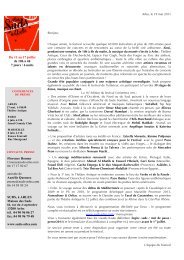GEO correspond-il à vos attentes ? - Les Suds à Arles
GEO correspond-il à vos attentes ? - Les Suds à Arles
GEO correspond-il à vos attentes ? - Les Suds à Arles
Create successful ePaper yourself
Turn your PDF publications into a flip-book with our unique Google optimized e-Paper software.
Made<br />
in <strong>Arles</strong><br />
The Amphitheater, or Arena, has better withstood the test of<br />
time, though its so<strong>il</strong> has soaked up unimaginable quantities of blood<br />
over the years. Bu<strong>il</strong>t in the 1st century A.D., it seated 20,000 spectators<br />
who came to watch gladiator combats, small game hunts and<br />
prisoner executions. During the Middle Ages, squatters bu<strong>il</strong>t a veritable<br />
v<strong>il</strong>lage of more than 200 houses inside its walls. After their eviction<br />
in 1830, the Amphitheater hosted its first courses camarguaises<br />
(games of sk<strong>il</strong>l against bulls) to cel-<br />
Bernard Coutaz<br />
moved his three-year-old company,<br />
Harmonia Mundi, from Paris<br />
to a h<strong>il</strong>ltop in the Luberon in 1961.<br />
Since then, this risk-taking independent<br />
label has bu<strong>il</strong>t up a large<br />
and loyal fan base with a winning<br />
formula: exploring lesser-known<br />
music, signing and developing new<br />
artists, and using period instruments<br />
when possible. One of its<br />
early ventures involved recording<br />
music played on historical organs<br />
throughout Provence.<br />
In 1986, the mayor of <strong>Arles</strong><br />
offered to rent the company a<br />
collection of farm bu<strong>il</strong>dings, including<br />
a lovely Provençal mas,<br />
just outside the city center. The<br />
entire complex included some<br />
100,000 square feet, and Coutaz<br />
leaped at the chance, selling his<br />
Luberon property and investing<br />
the proceeds in the business.<br />
In the years since, the company<br />
has branched into publishing and<br />
become renowned worldwide for<br />
reviving Baroque music; it now has<br />
distributors in 60 countries as well<br />
as 44 stores in France and three in<br />
Spain. “Between 2001 and 2006,<br />
the recording music industry lost<br />
50 percent of its market,” says<br />
Coutaz. “During that same period,<br />
our sales went up 30 percent.”<br />
That said, Harmonia Mundi has not<br />
been immune to the recent economic<br />
turmo<strong>il</strong>; Coutaz notes that<br />
sales are down 7 percent this year<br />
compared with 2008.<br />
The company’s flagship shop<br />
is located in <strong>Arles</strong>’s historic center<br />
and sells CDs as well as books.<br />
Nyssen has no problem with that,<br />
saying that <strong>Arles</strong> can eas<strong>il</strong>y accommodate<br />
both companies. “You<br />
might think that Harmonia Mundi’s<br />
store would have eaten into our<br />
profits, but it has only increased<br />
our sales. The more cultural activity<br />
there is here, the more people<br />
come. I am sure of it.” —AS<br />
Two of France’s most successful<br />
purveyors of culture have long been<br />
based in <strong>Arles</strong>—a small city far removed<br />
from the glitz and glamour<br />
of Paris’s intellectual and cultural<br />
scene. The publisher Actes Sud<br />
took up residence here in 1983,<br />
and the classical music label Harmonia<br />
Mundi followed in 1986. Between<br />
them, they provide work for<br />
several hundred people in this city.<br />
Both houses are independent,<br />
bu<strong>il</strong>t from the ground up to<br />
become leaders in their fields.<br />
Belgian native Hubert Nyssen<br />
created Actes Sud in 1978 in the<br />
Provençal v<strong>il</strong>lage of Paradou,<br />
where his daughter, Françoise,<br />
soon joined him. Shortly afterward,<br />
she met Jean-Paul Capitani, an<br />
<strong>Arles</strong>ian who owned a large fam<strong>il</strong>y<br />
property—a former dairy—in the<br />
city. They became personal and<br />
professional partners, converting<br />
the space into offices as well as<br />
a bookstore, restaurant, cinema<br />
and hammam. Together they bu<strong>il</strong>t<br />
Actes Sud into a major publisher<br />
with a yearly turnover of €70 m<strong>il</strong>lion<br />
and a roster of big-name authors<br />
that includes Paul Auster and<br />
Stieg Larsson, the late Swedish<br />
creator of the M<strong>il</strong>lennium tr<strong>il</strong>ogy.<br />
Sitting at a leather-topped desk<br />
with a plane tree outside her office<br />
window, Françoise Nyssen recalls<br />
the early days, when it was difficult<br />
to convince writers even to send<br />
manuscripts. “At the time, Paris<br />
was where everything happened,<br />
but our ph<strong>il</strong>osophy was simple.<br />
Why shouldn’t you pursue the career<br />
you want, where you want to<br />
live? We made the best of it. And<br />
then, once we got fax machines,<br />
then the Internet and the TGV, the<br />
tables turned and it was obviously<br />
more advantageous to be here<br />
than in the capital. We have fewer<br />
distractions. And we have the Provençal<br />
sunlight.”<br />
Bernard Coutaz was equally<br />
attracted by the quiet when he<br />
ebrate France’s capture of Algiers.<br />
They st<strong>il</strong>l take place here, as do<br />
Spanish-style corridas.<br />
The Romans may have had no<br />
problem k<strong>il</strong>ling people within city<br />
walls, but they insisted on burying<br />
the dead outside of them. Just beyond<br />
the stone fortifications is the<br />
Alyscamps necropolis, famous as the<br />
final resting place for Saint Genest,<br />
a clerk beheaded by the Romans because<br />
he refused to sign death sentences<br />
for Christians. (The religion<br />
took hold early here.) The cemetery<br />
became the point of departure for<br />
medieval p<strong>il</strong>grimages to Santiago de<br />
Compostela and later inspired paintings<br />
by Van Gogh and Gauguin.<br />
The Dark Ages saw <strong>Arles</strong> repeatedly<br />
sacked by barbarians, but by the<br />
12th century, it was thriving again as<br />
a free city and an important capital<br />
of Christianity. Romanesque constructions<br />
from this era include the<br />
gorgeous Eglise St-Trophime, with<br />
the Last Judgment carved on its portal.<br />
War and plagues cut short this<br />
golden age, and the city languished<br />
unt<strong>il</strong> the 16th century, when a Dutch<br />
engineer tamed the swampy Camargue<br />
by bu<strong>il</strong>ding canals. Landowners<br />
grew rich and bu<strong>il</strong>t impressive hôtels<br />
particuliers in the city, wh<strong>il</strong>e King<br />
Louis XIV’s official architect, Jules-<br />
Hardouin Mansart, helped design<br />
the majestic City Hall. These days,<br />
skateboarders practice on the square<br />
in front of the bu<strong>il</strong>ding wh<strong>il</strong>e a Communist<br />
mayor presides within.<br />
In recent years, sophisticated<br />
hotels and restaurants<br />
have sprung up all<br />
over town. opposite:<br />
The elegantly spare spa<br />
at the Hôtel Particulier,<br />
housed in a 19th-century<br />
mansion. below: A delectable<br />
Jerusalem artichoke,<br />
parmesan and truffle<br />
mousse by two-star chef<br />
Jean-Luc Rabanel.<br />
Tourism was an obvious option<br />
and now represents more than half<br />
of the city’s economic activity. Efforts<br />
to further enhance <strong>Arles</strong>’s re-<br />
markable historic heritage are ongoing: The Théâtre Antique and the<br />
Amphitheater—both black with age—are in the midst of a 10-year<br />
restoration. Work should be finished in 2012, but already the contrast<br />
between the untouched and the newly cleaned stones is striking. At<br />
the same time, an American organization called the World Monument<br />
<strong>Arles</strong>’s most recent decline was brought on by neither barbarians<br />
nor plague but rather by the end of the Industrial Age, during which<br />
the town flourished thanks to its ra<strong>il</strong>-repair yards. Opened in 1856, the<br />
Ateliers SNCF, as they became known, were long a p<strong>il</strong>lar of the local<br />
economy. But technology did not keep pace with the times, and by<br />
the mid-20th century, the yards, originally designed to service steam<br />
locomotives, were hopelessly outdated. The SNCF finally closed<br />
them in 1984, precipitating an economic catastrophe from which<br />
<strong>Arles</strong> has yet to recover. “The city lost its bearings,” says S<strong>il</strong>vie Ariès,<br />
a journalist for La Provence newspaper. “It had to reinvent itself.”<br />
France • summer 2009 43





